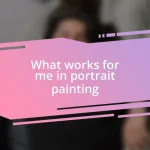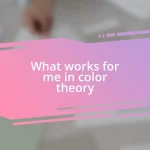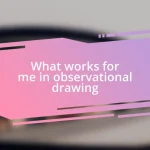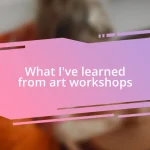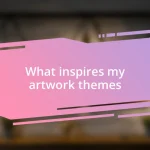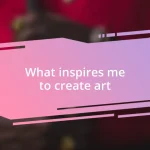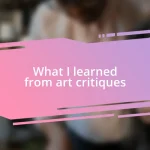Key takeaways:
- Translating personal experiences into art requires vulnerability and emotional honesty, creating a powerful connection with viewers through shared human experiences.
- Utilizing techniques such as symbolism, color palettes, and composition enhances visual storytelling, allowing emotions to resonate deeply and invite empathy.
- Engaging audiences by sharing personal narratives fosters dialogue and connection, transforming art into a relatable and shared experience that reflects common themes of humanity.

Understanding the process of translation
Understanding the process of translation is like peeling back layers of an onion, revealing deeper meanings and emotions with each layer. I often find myself reflecting on a pivotal moment in my life, a time filled with joy or sorrow, and the challenge is to express that nuanced feeling in a visual format. Can you imagine distilling a profound experience into a piece of art? It requires both sensitivity and creativity.
When I think about translation, I realize it’s not merely a change of medium but a re-interpretation of emotions and stories. I remember a time when I translated my feelings from a breakup into a series of paintings. Each stroke of the brush was a raw expression of my heartache, allowing the viewer to feel my pain and resilience. It’s fascinating how colors and textures can evoke sentiments that words sometimes fail to capture.
Moreover, this translation process often demands vulnerability—you must expose your true feelings to create something meaningful. I’ve learned that when I embrace my emotions fully, whether it’s joy, sadness, or nostalgia, the artwork becomes a powerful mirror reflecting not just my experiences but also resonating with others. Have you ever created something that stirred such deep emotions within you? It’s in these moments that translation transcends art, becoming a shared human experience.

Recognizing personal stories’ significance
Recognizing the significance of personal stories is essential for anyone looking to translate their experiences into art. Each story holds a unique essence, often shaped by the emotions tied to pivotal moments in our lives. I recall a childhood memory of standing in my grandmother’s kitchen, captivated by the scents of spices and freshly baked bread. That simple scene speaks volumes about comfort, love, and tradition—elements that I now weave into my artwork.
When I focus on the stories that resonate most with me, they often unlock profound insights about my own identity. For instance, during my teenage years, I faced struggles with self-acceptance. Translating that feeling into a sculpture allowed me to confront those insecurities and emerge with a piece that visually narrates my journey toward self-love. It’s incredible how the act of translating these personal tales into art helps unravel complex emotions and offers healing.
Lastly, the power of storytelling in art lies in its ability to connect with others. I remember sharing a piece inspired by my father’s resilience after losing his job. The reaction was overwhelming; people approached me not just to compliment the work, but to share their own experiences of loss and recovery. It made me realize that when we recognize the significance of personal stories, we create a shared tapestry of experiences, binding us together through our vulnerabilities.
| Aspect | Significance |
|---|---|
| Emotional Depth | Personal stories add layers of emotion, enriching the artistic expression |
| Identity Exploration | They help in understanding and nurturing one’s identity over time |
| Connection | Art becomes a bridge, linking similar experiences and fostering community |

Techniques for visual storytelling
When it comes to visual storytelling, I’ve found that employing various techniques can truly bring a personal narrative to life. For instance, I often use a color palette to evoke specific emotions tied to my experiences. One time, I created a piece using warm reds and oranges to capture the intensity of a moment filled with love and passion, while softer blues reflected moments of tranquility and introspection. It’s amazing how color can act as an emotional guide for both the artist and the viewer.
To enhance the storytelling aspect, I also incorporate the following techniques:
- Symbolism: Using objects or motifs that represent emotions or themes within the story. For instance, a broken watch can signify lost time or broken dreams.
- Composition: Arranging elements in a way that draws the viewer’s eye and creates a narrative flow; for example, placing a solitary figure in a vast landscape can evoke feelings of isolation.
- Texture: Employing different materials and techniques to evoke sensory experiences that resonate with the themes of the story; for instance, rough textures might symbolize struggle, while smooth surfaces reflect ease.
By weaving these techniques together, I’ve been able to transform raw emotions into compelling visual stories that invite viewers into my world, creating connections through shared understanding and empathy.

Combining emotions with artistic elements
Combining emotions with artistic elements is where I find a true alchemy of expression. I recall a time when I was working on a painting that reflected a bittersweet farewell to a friend moving away. I decided to blend contrasting elements: vibrant bursts of color symbolizing joy, interspersed with dark, muted tones reflecting my sadness. It was a poignant reminder that beauty and sorrow often coexist, and I wanted my audience to feel that tug-of-war in their hearts, too.
As I explore this interplay further, I often think about how specific shapes can amplify the emotional weight of a piece. A sharp, jagged edge can echo feelings of anger or frustration, whereas soft, rounded forms tend to inspire comfort and safety. For example, in a sculpture representing regret, I chose angular cuts that felt almost aggressive. It might seem unexpected, but I wanted to communicate how regret can feel like a sharp pain, rather than a gentle sadness. How does each shape make you feel? That’s the question I keep coming back to.
By fusing these emotional layers with intentional artistic choices, I create a dialogue between the viewer and the artwork. I remember displaying a mixed-media piece that combined fabric, paint, and photographs from my past. As people interacted with it, I noticed their expressions shift—some smiled, others looked reflective. It reinforced my belief that when emotions are paired with carefully chosen artistic elements, we open a gateway for others to connect with our experiences and perhaps even evoke their own stories. Isn’t that what art is truly about?

Showcasing your translated art
Showcasing translated art is an experience that can be both exhilarating and nerve-wracking. I remember when I first displayed my artwork at a local gallery. Seeing my pieces hung on the walls, telling my stories to strangers, was like sharing a part of my soul. Have you ever felt that way? It’s humbling to realize that your personal journey resonates with others, opening up dialogues you never anticipated.
When I showcase my art, I find it crucial to create an environment that amplifies the emotions behind my works. For instance, during an exhibit dedicated to themes of nostalgia, I dimmed the lights and played soft, familiar tunes from my childhood. This thoughtful backdrop set the tone, inviting viewers to immerse themselves in the feelings tied to the visuals. Have you thought about how you can enhance your art’s emotional landscape through your display? The right atmosphere can really draw people into your narrative.
Finally, engaging with viewers while they experience my art provides insights that are invaluable. I often encourage questions and discussions, allowing others to share their interpretations and stories. I recall a moment when a stranger connected with a piece about loss; they opened up about similar experiences, bringing tears to our eyes. It struck me then how art not only showcases our own stories but also acts as a mirror, reflecting the shared humanity we all carry within us. How do you encourage conversation around your own art?

Engaging audience through personal narratives
Engaging with an audience through personal narratives can transform art into a powerful experience. I recall once sharing a series of paintings based on dreams I had as a child. The viewers were drawn in, not just by the colors, but by the stories behind each piece. One woman came up to me, her eyes glittering with nostalgia, and shared how my painting of a moonlit forest reminded her of her own childhood adventures. It’s moments like these that reinforce how a personal story can resonate universally, creating a bridge between lives.
I often think about the choice of words I use when describing my work. During a recent opening, as I spoke about a piece reflecting my struggles with self-acceptance, I noticed how my vulnerability encouraged others to share their own experiences. It was fascinating to see how my story sparked a conversation about their journeys. Questions like “What does this piece make you think of?” or “Can you relate to this feeling?” invite deeper engagement. Have you considered how your narrative might open doors to discussions and connections?
Incorporating personal anecdotes into my artistic practice has taught me that authenticity is key to engaging an audience. I remember showing a piece about overcoming heartbreak, revealing how it echoed a specific moment in my life. The rawness of that memory struck a chord; I could see it in their faces. When we allow our audience a glimpse into our innermost struggles, we transform art into an empathetic experience. How does your own vulnerability shape the narratives you want to share?
